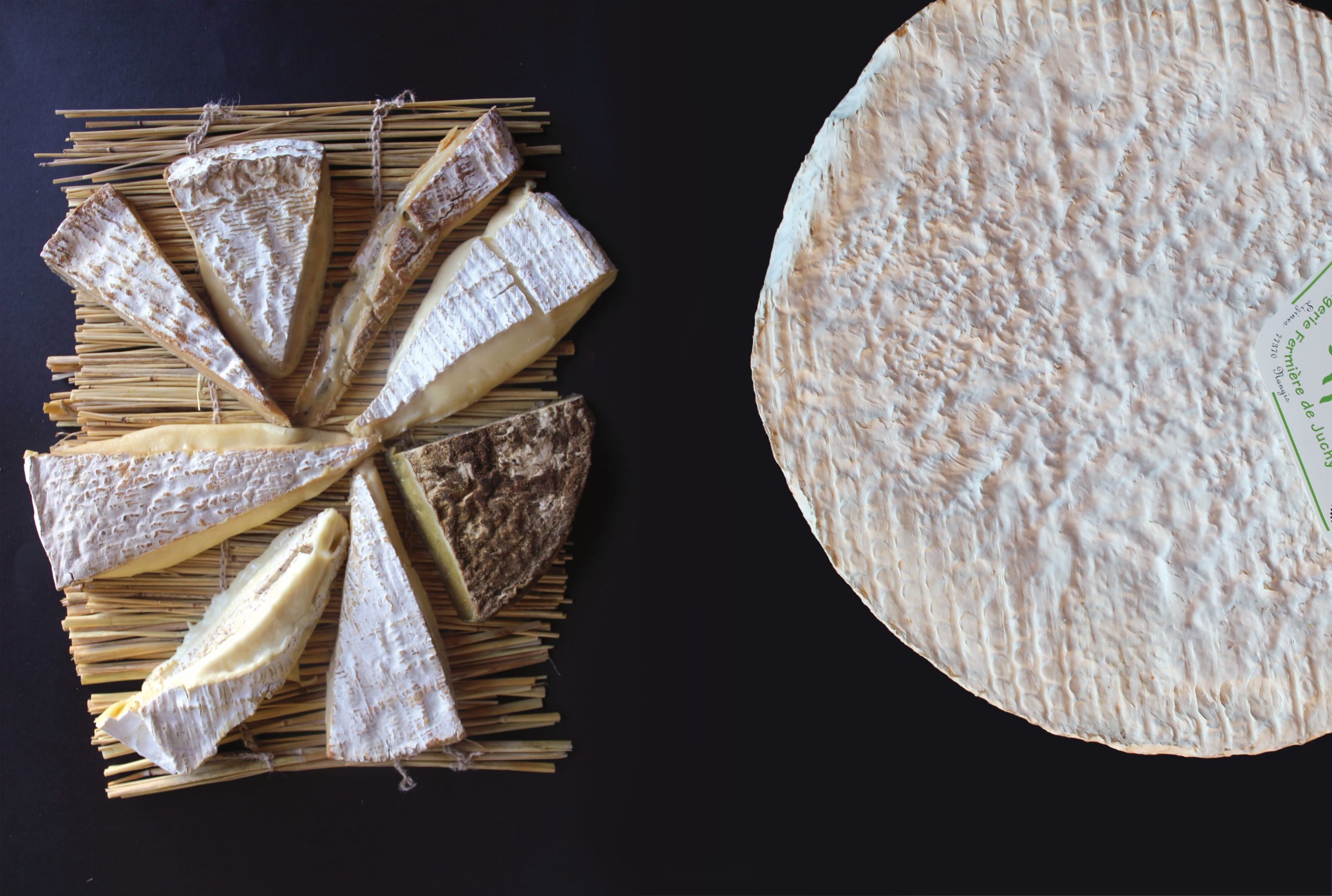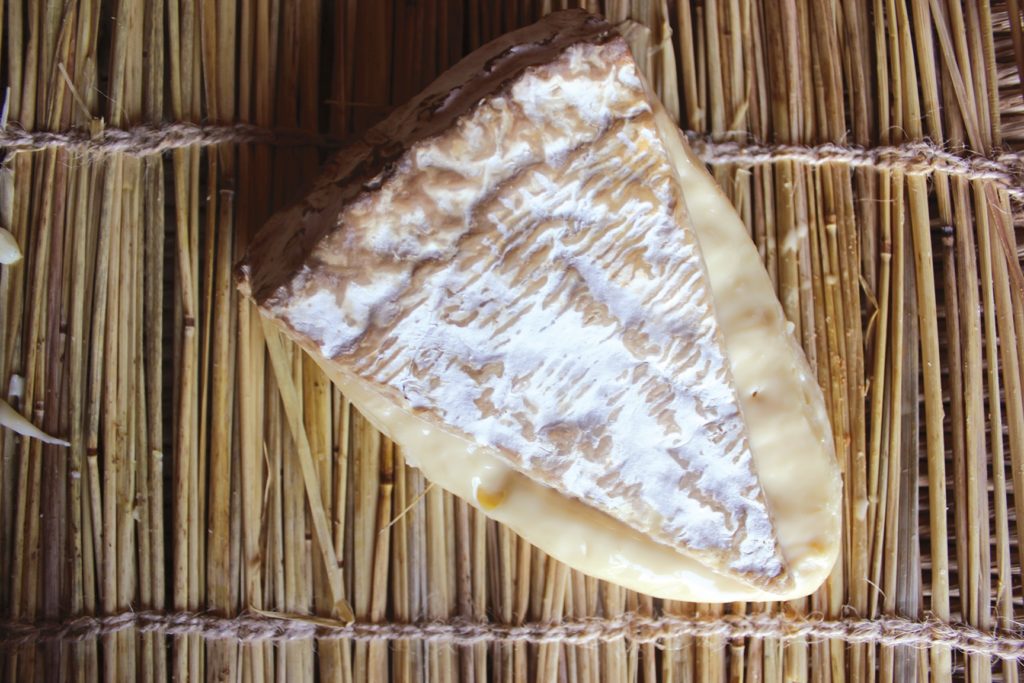
Soft and curvy, with oozing, voluptuous love handles, Brie has enchanted poets and emperors for centuries. “One has only to press it with one’s fingers,” wrote 17th-century poet Marc-Antoine Girard de Saint-Amant, “for it to split its sides with laughter, and run over with fat.” Charlemagne was less poetic but equally infatuated with the cheese. “I have just discovered one of the most delicious things,” the emperor declared during an eighth century visit to Reuil-en-Brie.
Fifth-generation affineur Stéphane Gay is well acquainted with Brie, including Brie de Meaux—unlike the rubbery, snow-white-rinded cracker-topper of Christmases past, it is pillowy soft yet mouth coatingly rich, with a flavor reminiscent of truffle butter. Perhaps if you were as powerful as the Roman emperor, you might bring this cheese home for the holidays but this is currently impossible for US consumers; real Brie de Meaux must be made with raw milk, which renders it contraband in America. (Unless it’s 60 days old, of course—but few Bries live that long, and those that do would be well past their prime when finally reaching the states).
Gay ages his cheeses in the caves at Fromagerie Ganot in Jouarre, the heart of Brie country east of Paris. It’s this fertile landscape that has shouldered the burden of feeding the City of Light for centuries. Brie is the region’s most famous cheese, a staple on the tables of both kings and peasants.
In the past each town made its own version, but today only two—Brie de Meaux and Brie de Melun—are protected with a French AOC (Appellation d’Origine Contrôlée). For these traditional cheeses, the milk source, process of production and aging, even the way they’re sliced (like a pie, down the middle only), are safeguarded under French law.
At 15 inches in diameter, a wheel of Brie de Meaux is impressive. Gay runs a small museum above his caves, where he walks visitors through the traditional Meaux production process. The key to its oozing creaminess is gentle treatment of the curd, which is hand-scooped into molds using a special perforated ladle, called pelle à Brie, and left to drain under its own weight on a straw mat.
Wheels are sprinkled with salt and sprayed with a mist of Penicillium mold, then left for at least a month of careful turning and aging. Given their huge surface area, dampness evaporates quickly on the outside, sealing moisture inside.
In years past, Gay says, Brie was made twice daily right on the farm, with curd from the evening milking scooped on top of curd from the morning milking. This story doesn’t fit with the sprawling wheat fields that cover much of the region—where are the cows?
The demand for real estate near Paris and the comparative ease of wheat production have pushed dairy farmers further away. The AOC has adapted: Milk may be sourced from an area that has expanded gradually over time, including the Seine and Marne counties, where Brie originated, to portions of other counties to the east. Most Brie is now produced using milk pooled in large facilities, meaning it must be cooled for transport and then rewarmed again.
At La Ferme de Juchy, east of Château de Fontainebleau, lives an elusive species: a farmstead Brie-maker. Rarer still, Jean-Claude Pette is producing one of only two remaining farmstead versions of the lesser-known Brie de Melun. Aged longer than Brie de Meaux, for 8 to 10 weeks, it’s musty, barnyardy, and much firmer. According to Pette, Melun is not only more complex in taste—it’s also closer to le Brie’s ancestors.
The main difference lies in the milk coagulation; enzyme rennet is used to make Meaux, while Melun relies on lactic acid bacteria for fermentation. Pette adds lactic ferments just after milking and leaves them to work for about 18 hours. Because lactic fermentation results in a more delicate cheese that is difficult to turn and transport, molds for Melun are smaller.
“Originally we just made cheese,” Pette says. “There wasn’t Meaux or Melun; it was just Brie. And it was a lactic cheese.”
As rennet technology became more accessible, cheesemakers switched over. Waiting almost a whole day for coagulation and scooping curd by hand (moulé à la louche) might have been an obsolete practice by now if it weren’t for AOC regulations. “The Appellation has saved the Brie de Melun,” Pette says.
An AOC protects the cheeses’ full name, but ‘brie’ remains fair game. One of Gay’s goals is to educate French consumers about how to identify and select perfectly ripe AOC Brie among countless imitations.
In the cave, the difference is clear: Young Bries are full of moisture, with a white surface. Sold by the kilo in French supermarkets, non-AOC versions may be released too early, when they’re heavier with water. Also, ultra pasteurized milk results in less diversity of surface flora.
“Never buy a Brie with an all-white rind,” Gay explains. “Buy the one that has some red and brown. In general that’s the sign of a cheese made with raw milk, and it’s a natural crust.”
But how can Americans follow this advice if AOC Brie is unavailable stateside? According to Tyson Danilson of Seattle importer Peterson Company, there’s hope. The obstacle to finding quality French Brie stateside isn’t just about raw milk, he says; it’s also about supply and demand. “People are used to Brie being inoffensive, bland, white,” Danilson says, “but there’s such an interest now in full-flavored cheeses.”
As such, Americans are creating more robust cheeses. French exporters, however, may be slower to catch on. “As an importer we run into a challenge about the image of the American consumer in the eyes of the French,” Danilson says. “Producers say, ‘You want young cheeses, mild cheeses,’” referring to American cheese tastes in general, “and sometimes it takes a lot of convincing to get them to send you the really good stuff.”
So Danilson teamed up with Hervé Mons to create Brie du Pommier, a version especially for the American market that “stinks so good.” Milk is pasteurized (so the cheese may be imported to the US), but that’s compensated for by its careful transport and handling, as well as the addition of cultures that replicate raw milk composition.
Still, there’s something about tasting Brie de Meaux in France that will make you nostalgic.
“Why, then, is it not endless, as indeed its circular form is endless?” grieves Saint Amant in a Brie-inspired poem. “And why must its full moon, eternally appealing, wane to a crescent?”
Stateside Suggestions
Several French producers now focus on producing high-quality, pasteurized-milk Brie especially for the American market. Cheese importer Alain François suggests Fromage de Meaux from Fromagerie Rouzaire in the Île-deFrance region, which also produces AOC versions, and Fromagerie de la Brie, which makes a three-kilo wheel specifically for US export.
His favorite is Brie Fermière from Ferme de la Tremblaye, the private family dairy of Jean-Noël Bongrain, founder of one of France’s largest dairy companies. Though only two pounds and made outside of the AOC region, it’s a farmstead cheese that showcases the utmost respect for tradition.
For Frenchman François, these versions are just fine. “A purist would say that there’s a difference,” he says, “but when I go to France and taste the raw milk Brie, and then I taste these, there’s not much difference for me.”
Also look for cheese from Chantal Plasse: Brie de la Brie, Brie de Montereau, and the mushroomy Coulommiers.
Tasting Notes
Brie de Meaux
Ferme des 30 Arpents
Favières, France
The only remaining AOC-certified Brie de Meaux fermière (farmstead) is produced on a sprawling estate
owned by billionaire banker Benjamin de Rothschild. It’s the friendliest Meaux we’ve tasted: rounded, savory, and salty with a slight spiciness and notes of almond.
Nugier Brie de Meaux
Société Fromagère de Raival
Raival, France
It’s clear when tasting this cheese, produced at a Lactalis-owned dairy, that despite the AOC stamp no two Meaux are created equal. Texture is firm and a thick crust dominates flavor with tonguenumbing intensity.
Dongé Brie de Meaux
Fromagerie Dongé
Cousances-lès-Triconville, France
This third-generation family dairy employs a slow maturation of six to seven weeks, well beyond the four required by the AOC. The cheese has a thick rind and a yellow paste that is creamy and earthy with distinct forest floor notes.
Brie de Melun
Fromagerie Loiseau
Achères la Forêt, France
Fromagerie Loiseau has been aging Brie since 1921, specializing in the more elusive Melun. Flavor is strong and musky, reminiscent of wet leaves in autumn, with a spicy kick on the back of the tongue and a lingering finish.
Brie de Melun
La Ferme de Juchy
Lizines, France
Lactic and slightly sour with a chalky white center, Jean-Claude Pette’s cheese is “closer to chèvre than Camembert,” he says. We agree: Produced by Fromagerie Loiseau, it’s firmer and milder than Melun, with a salty, rounded taste.
Brie Noir
Fromagerie Ganot
Jouarre, France
Fromagerie Ganot ages some wheels for up to two years, until they’re dark brown with crust completely chewed up by cheese mites. The taste of a one-year-old version is strong but pleasantly surprising; it’s still creamy, with aromas of porcini mushrooms and roasted nuts. Scrape off some of Brie Noir’s rind before eating, and try dunking a slice in coffee.
Brie à la Moutarde
Fromagerie Ganot
Jouarre, France
Stéphane Gay slices fresh Brie de Meaux in half and sandwiches in local mustard. During aging the outside develops like other Brie, hiding a buttery center layer flecked with tangy mustard seeds that stand up to the cheese’s creaminess.
Délice de Favières Truffé
Ferme des 30 Arpents
Favières, France
Brie Truffé is a treat that graces French tables around Christmas and New Year’s. The earthiness of its thick, potent rind is only enhanced by a middle layer of puréed black truffle.





